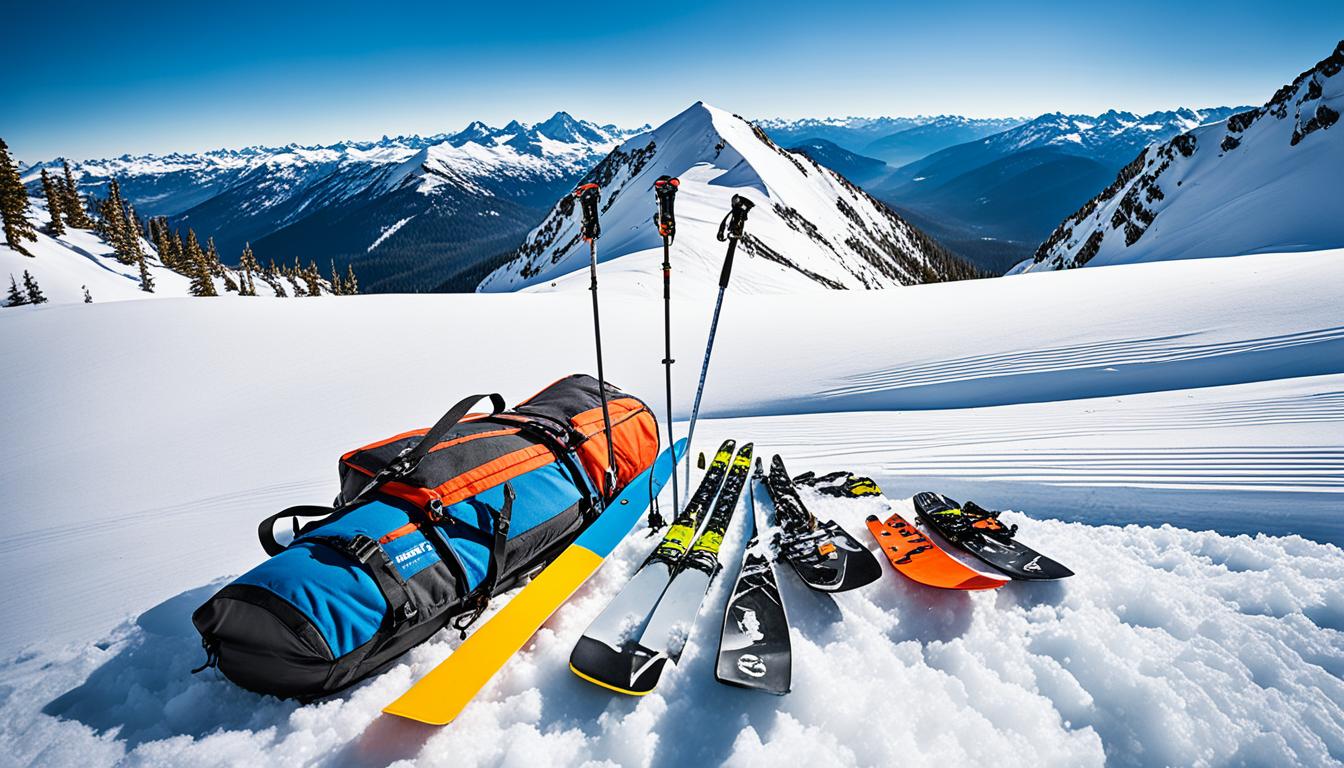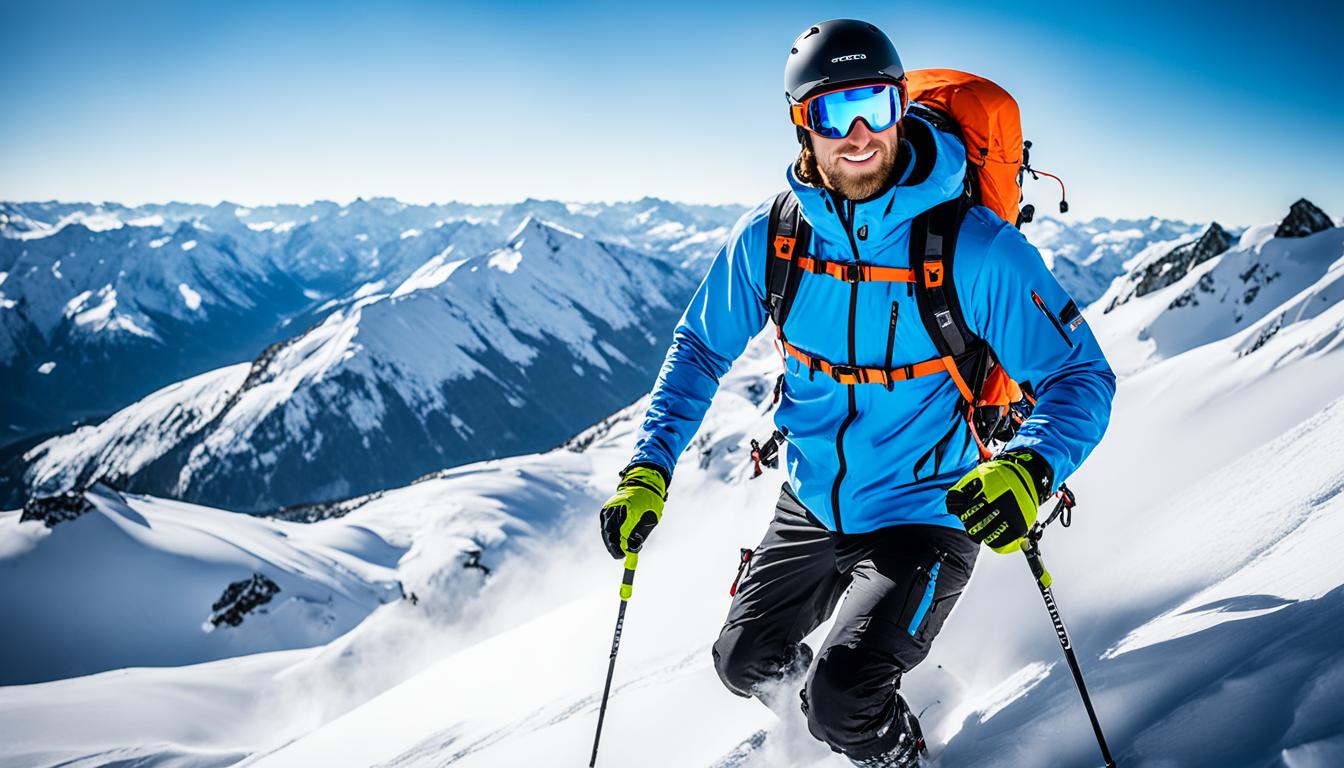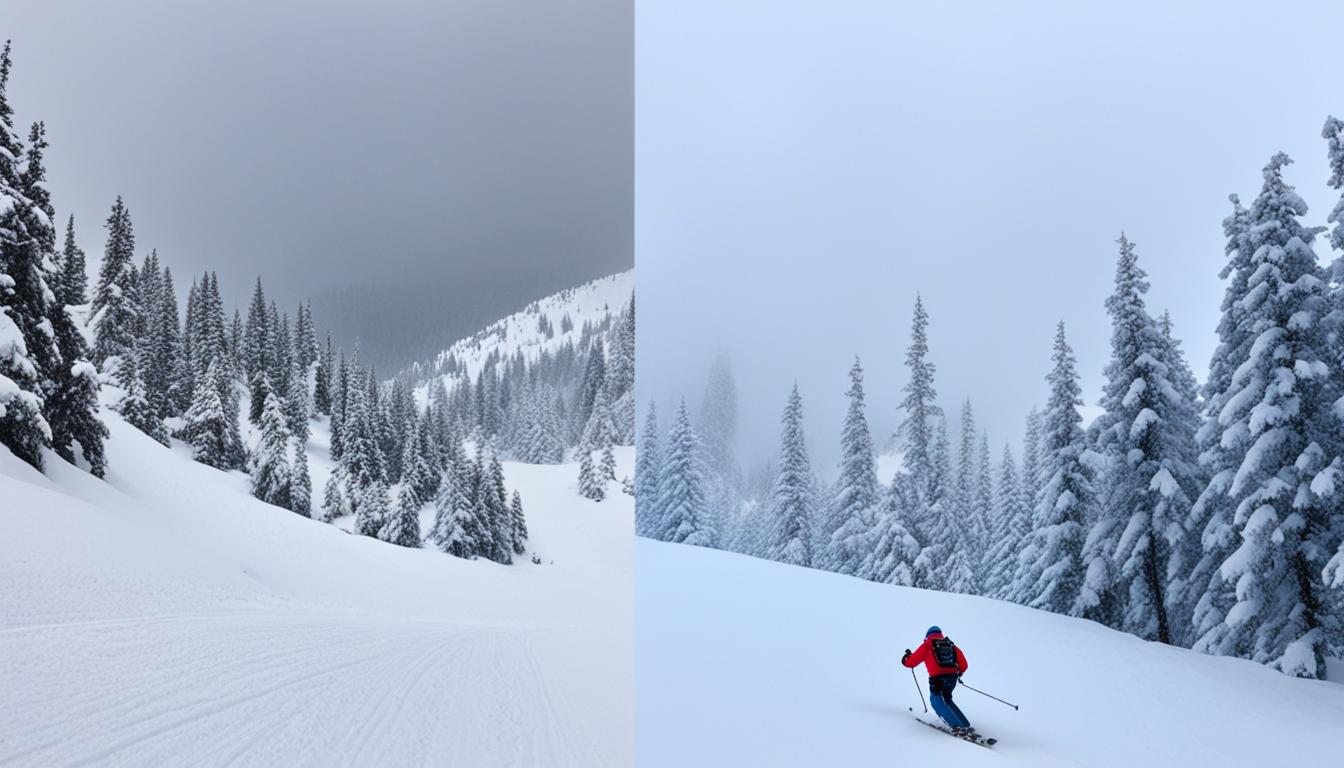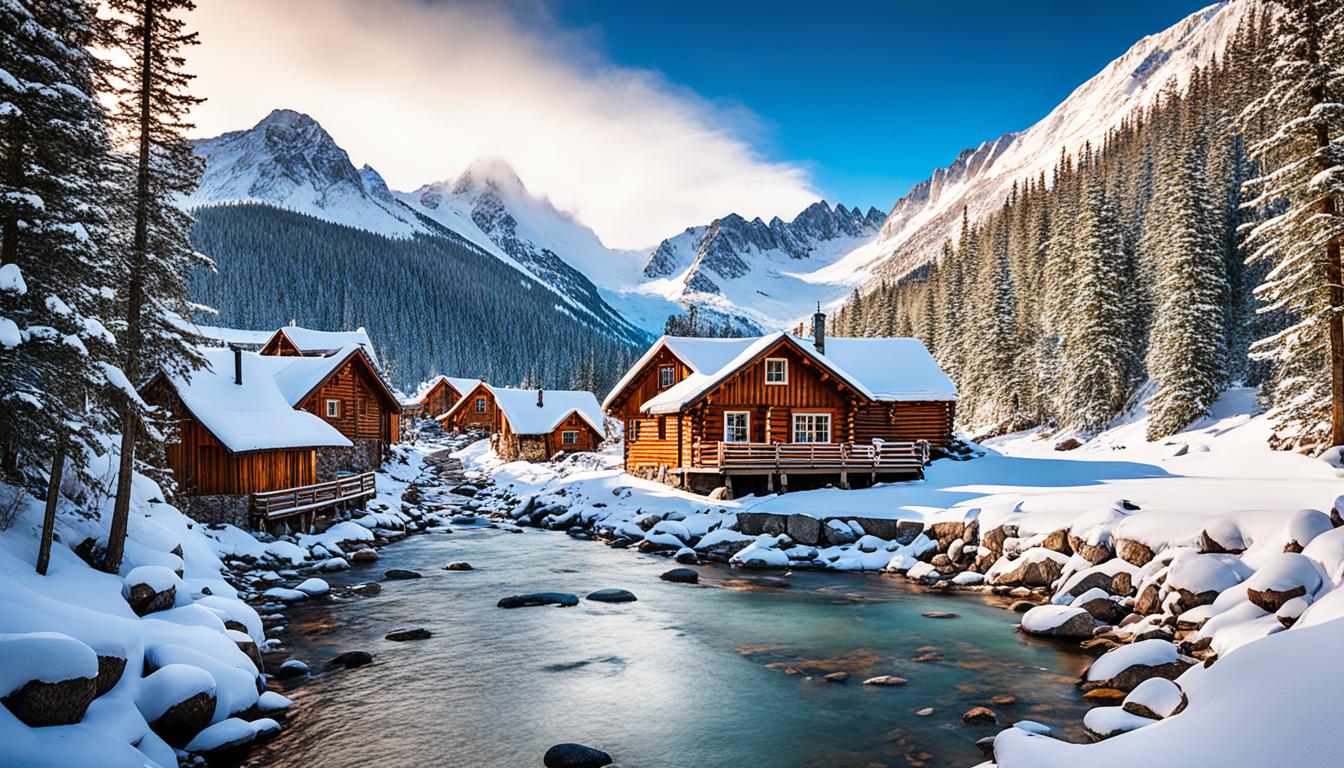Ready to boost your backcountry skiing adventures? It’s time to up your training. You need endurance, balance, and strength for backcountry skiing. Adding specific exercises to your routine is key. This prepares you for the fun of untouched powder and the peace of nature.
This article will share key info on backcountry skiing training. It’ll make you better on the slopes, boost your fitness, and keep you safe in the mountains. Whether you’re experienced or just starting, these tips will improve your performance.
Key Takeaways:
- Backcountry skiing requires endurance, balance, and strength.
- Incorporate specific workouts into your training plan.
- A proper warmup is crucial before engaging in any workout.
- Exercises should target the muscles used in backcountry skiing.
- Start training at least six to eight weeks before the season begins.
The Importance of Warmup and Workout Exercises
Starting with a warmup before your workout is key, especially for activities like backcountry skiing. This step gets your body ready to move, lowering the chance of getting hurt. It also helps you do better when you’re out on the slopes. Make sure your warmup includes exercises that focus on the muscles you’ll use most.
Warmup Exercises
Begin with lunges that go in several directions to warm up your quads, glutes, and hamstrings. You’ll step forward, back, and to the side. This mimics what you do while skiing in the backcountry.
After those, do plank walk-outs to shoulder taps. They work your core and your shoulders. Get into a plank, then walk your hands out and do a push-up. Tap your hand to the opposite shoulder, keeping your core tight.
“A proper warmup prepares your body for the demands of backcountry skiing and helps prevent injuries.”
Also, focus on your core by doing mountain climbers and Russian twists. These exercises make your core stronger. They also help you stay stable and balanced on rough ground.
Workout Exercises
Next is the workout part. These exercises are meant to boost your strength for backcountry skiing:
- Single-leg dumbbell deadlifts work the hamstrings, glutes, and lower back. They build leg stability, important for rough ground.
- Bent-over dumbbell rows improve your back and shoulders. This makes your skiing posture better and helps you keep balance.
- Banded side steps with a resistance band are for the glutes and outer thighs. They boost stability and side-to-side movement.
- Arnold presses strengthen the shoulders and upper body. They’re key for carrying gear and moving skis around.
- Dumbbell hip thrusts focus on the glutes and hamstrings. They are good for hill climbing and making strong, quick moves.
- Banded lat pulldowns work your back. A strong back helps keep a good position and control while skiing.
Adding these exercises to your backcountry ski routine will improve your fitness. They ready your muscles for the specific challenges of backcountry skiing. By training regularly, you’ll be more confident and have better stamina in the backcountry.
Training Schedule and Exercises
Backcountry skiing needs you to be strong and fit. Start your training six to eight weeks before hitting the slopes. This time lets your body get ready for the tough ski conditions.
Try to work out two to three times a week to make your legs stronger and boost your balance and control. You also need to work on lasting longer and improving your heart health with two to three days of cardio each week.
Consider these training plans and exercises for skiing:
Walking Lunges with Rotation
This workout works multiple leg muscles and twists your torso. Start with your right foot forward and bend both knees. Twist your upper body right as you lunge. Then, switch sides and repeat.
Skaters with Uppercuts
This move helps with side-to-side skiing motion. Begin in a low squat with your arms ready. Jump to the right, using your left arm to punch up. Switch directions and keep going.
Single-Leg Squats and Rows
This exercise boosts back leg muscles and your upper body. Stand on one leg, the other lifted. Squat down on your standing leg while pulling a weight up with the opposite arm. Do this on both legs.
Step-Ups with Lateral Leg Raises
It works your butt, front leg, and outer thigh. Step up with your right foot on a raised platform. As you do, lift your left leg to the side. Then, switch feet and repeat.
Chop Exercises
Chops help make your core strong. Use a cable or band with your legs apart. Pull the cable across your body, tightening your core. Do it on both sides.
Always do exercises the right way. Make workouts harder as you get better. To get a perfect plan, talk to a fitness expert or coach.
Use these top skiing workouts to get ready for the backcountry. You’ll love the thrill of skiing even more.
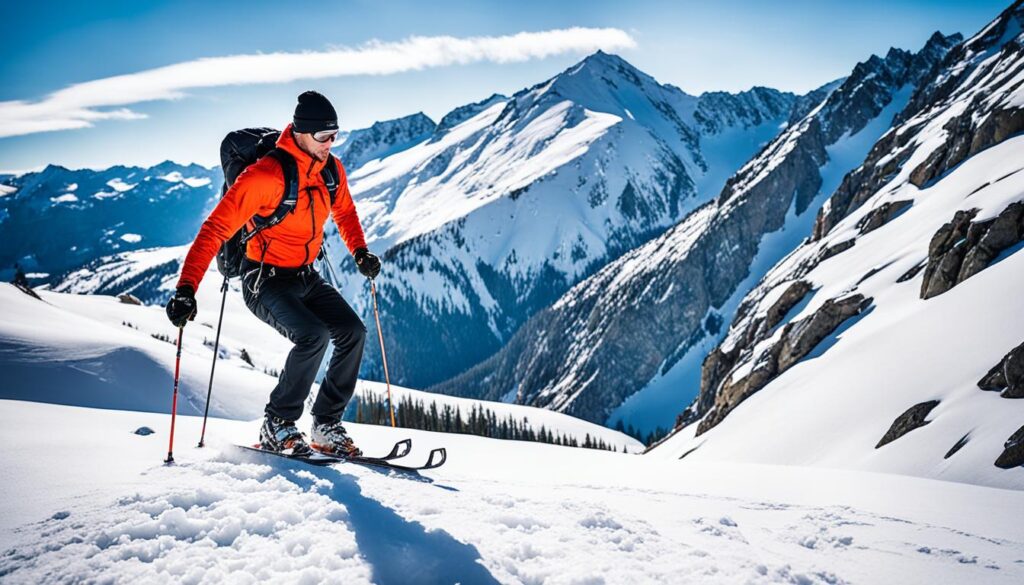
Choosing the Right Gear
Backcountry skiing needs the right gear for fun and safe trips. Your skiing style and the terrain are key for picking the right gear. Let’s talk about the essentials:
1. Alpine Touring Skis
Alpine touring skis are built for the backcountry. They are lighter than traditional skis. This makes walking uphill easier. They also give you good control on different surfaces.
2. Skins
Skins stick to your skis’ base for climbing. They help you move up without slipping backward. Skins are a must-have for steep or icy slopes.
3. Bindings
Bindings let your heel move up when climbing. This mimics walking naturally. They can also lock down for skiing down, giving you control and stability.
4. Boots
Backcountry boots can be locked or not for different uses. They have a mode for easier walking uphill. Pick boots that are light, tough, and fit well.
5. Poles
Use adjustable poles for backcountry skiing. You can change their length. This helps with different terrains. Make sure your poles have strong baskets for support in snow.
Getting the right backcountry ski training is smart. It helps you choose the best gear for your needs. The right equipment boosts how much you enjoy the outdoors.
Additional Gear and Safety Considerations
When you head to the backcountry for skiing, having the right gear is key. It’s not just about what’s basic anymore. Make sure you’re safe and ready with these extra steps:
- Backcountry Ski Packs: Pick a top-notch ski pack that’s roomy. Ideal for packing your must-haves. Look for ones with lots of pockets for neat storage.
- Avalanche Rescue Tools: Always bring along a strong shovel and a trusty probe for avalanches. They play a big role in saving lives during emergencies.
- Avalanche Beacons: For safety in the backcountry, a beacon is a must. It helps find people trapped under snow. Take a safety class and practice with it so you know what to do in an emergency.
- Survival Features: Think about packs that have special survival tech like Avalungs or airbags. Technology can up your survival chances if an avalanche happens.
Your safety is more important than the thrill. With the right gear and being ready, your skiing trips can be safe and fun.
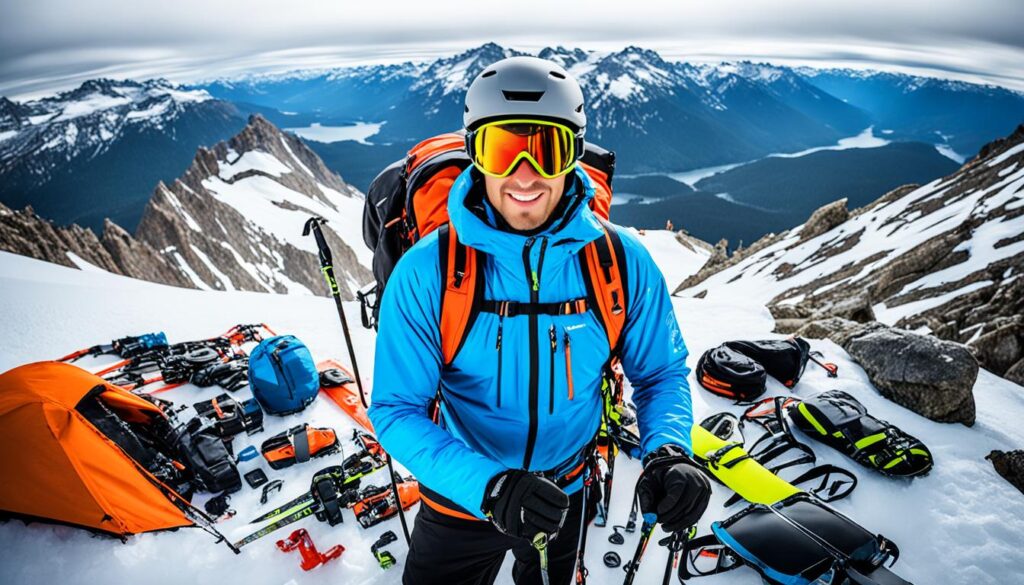
Avalung: A Life-Saving Device
The Avalung system has become a hit for those skiing in wild places. It’s a mask that keeps carbon dioxide away. This way, you can breathe easier under snow. It buys you time until rescuers find you, a potentially life-saving tech.
Always check and look after your gear. This ensures it does its job well. Knowing your safety basics makes skiing in the wild better and safer.
Conclusion
Adding backcountry ski training to your fitness routine is a smart move. It makes you better at backcountry skiing and keeps you safe. These programs boost your stamina, strength, and balance. They help you feel more secure on challenging slopes.
Focus on exercises that work the muscles you need for backcountry skiing. This includes your quads, glutes, and core. Building strength will make uphill climbs and deep snow easier. Cardio exercises will boost your fitness and keep your energy high.
The right gear is also key for backcountry skiing. Pick quality items like alpine touring skis and boots made for off-trail use. Always bring safety gear, including items for avalanche rescue.
Planning and training are important for backcountry skiing. With the right programs and gear, you can enjoy the untouched snow and peace of nature. Get ready to make amazing memories on the slopes.
FAQ
What are the essential components of backcountry skiing training programs?
These programs mix endurance, balance, and strength workouts. They work the specific muscles needed for backcountry skiing. Plus, they boost your overall fitness.
Why is warmup important before engaging in backcountry ski workouts?
Before workout, warmup is key. It hits muscles like quads, glutes, and back. This preps your body, lowers injury risk, and ups your skiing game.
What exercises should I include in my backcountry ski training program?
Include single-leg dumbbell deadlifts and banded side steps. Also, do bent-over rows, Arnold presses, hip thrusts, and lat pulldowns. These workouts boost your strength, control, and balance.
How long before the backcountry skiing season should I start training?
Start your training at least six to eight weeks in advance. This gives you time to get stronger, build stamina, and get in better shape.
What gear do I need for backcountry skiing?
For backcountry skiing, you’ll need alpine touring skis, skins, bindings, boots, and poles. Skis are lightweight for backcountry. Skins help with traction, bindings support movement, and boots should have a walk mode. Adjustable or collapsible poles are a good idea.
Are there any additional gear considerations for backcountry skiing?
Absolutely. You must have a ski pack to carry avalanche gear like a shovel and probe. An avalanche beacon is vital for safety. Packing survival gear like Avalung or airbags boosts your protection against an avalanche.
How can backcountry skiing training programs enhance my skiing experience?
These programs not only make you fitter but also boost your skiing skills. This means more stamina, strength, and balance on the slopes. Enjoy the fresh snow and nature’s peace even more.

